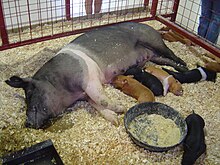
The Nigerian Dwarf is a modern American breed of dwarf goat. Like the American Pygmy Goat, it derives from the West African Dwarf group of breeds of West Africa.
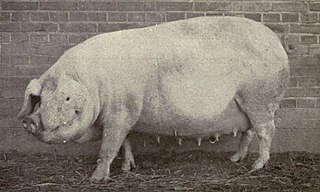
The Danish Landrace, Danish: Hvid Dansk Landrace, is a Danish breed of pig. It is of medium to large size, white in colour with a long body, fine hair, a long snout, and heavy drooping ears. There are two distinct varieties, the white and the piebald.

The Tamworth is a British breed of domestic pig. It is the only red-coloured British pig. Its origins are unknown, but it appears to have developed near the town of Tamworth in south-eastern Staffordshire, close to Warwickshire border. It is one of seven British pig breeds listed by the Rare Breeds Survival Trust as 'priority', the highest level of concern of the trust.

The Oxford Down is a British breed of domestic sheep. It was developed in the 1830s by cross-breeding of Hampshire Down and Southdown ewes with Cotswold rams. It is reared primarily for meat.

The Katahdin is a modern American breed of sheep. It is an easy-care sheep: it grows a hair coat with little wool which moults naturally in the spring, and so does not need to be shorn. It is reared for meat only.
The Indu-Brasil or Indo-Brazilian is a Brazilian breed of zebuine beef cattle. It was bred in the early twentieth century in the Triângulo Mineiro in the western part of Minas Gerais state, and particularly in the area surrounding Uberaba. It was originally known as the Induberaba. It derives from imported Indian zebuine cattle, principally Gir and Kankrej. It was formerly an important beef breed, but in the twenty-first century is an endangered breed. It is characterised by particularly large ears, perhaps the largest seen in any breed of cattle.
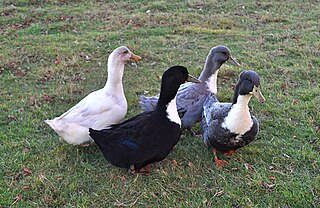
The Swedish Blue or Blue Swedish is a Swedish breed of domestic duck. It originated in the former dominion of Swedish Pomerania – now in north-west Poland and north-east Germany – and is documented there from 1835. It is closely similar to the Pomeranian Duck from the same general area, differing mainly in its white primary feathers.
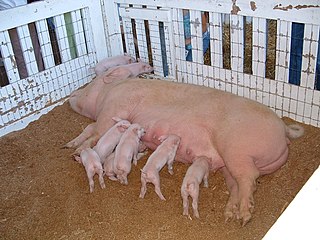
The American Yorkshire is an American breed of large domestic pig. It is the most numerous pig breed in the United States. It derives from pigs of the British Large White or Yorkshire breed imported from the United Kingdom or from Canada at various times from about 1830 to the mid-twentieth century.

The Berkshire is a British breed of pig. It originated in the English county of Berkshire, for which it is named. It is normally black, with some white on the snout, on the lower legs, and on the tip of the tail.
The Semirechensk is a Kazakh breed of domestic pig. It was purpose-bred in the twentieth century in the Kazakh Soviet Socialist Republic of the Soviet Union. The breeding stock was principally Large White, with some admixture of Siberian Kemerovo and a small proportion of wild boar.

The Poland China is an American breed of domestic pig. It was first bred in Warren County in Ohio, in the American Midwest. Its origins lie in a small number of pigs of Chinese type bought in 1816, which were cross-bred with a variety of breeds of European origin including the Berkshire. It was bred as a lard pig, and is among the largest of all pig breeds.

The Red Wattle Hog is a breed of domestic pig originating in the United States. It is named for its red color and distinctive wattles or tassels, and is on the threatened list of the American Livestock Breeds Conservancy (ALBC).

The British Saddleback is a modern British breed of domestic pig. It was created in 1967 by merging the surviving populations of two traditional saddleback breeds, the Essex and Wessex Saddleback. It is an endangered breed, listed on the watchlist of the Rare Breeds Survival Trust as at risk, the second-highest level of concern.
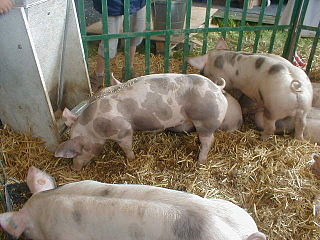
Piétrain is a Belgian breed of domestic pig. It is native to Wallonia, and takes its name from the village of Piétrain in the municipality of Jodoigne in Walloon Brabant, in northern Wallonia. It first appeared in about 1920, and received recognition as a breed in 1950. Its origins are not clear; it has been suggested that the farmers of Piétrain may have recognised, and selectively bred for, a genetic mutation causing muscular hypertrophy.

The Oxford Sandy and Black is a British breed of domestic pig. It originated in the county of Oxfordshire, and is named for that and its colour, which is a sandy brown with black patches. It is believed to be one of the oldest British breeds of pig.

The Guinea Hog is an American breed of small black pig. Since 2006 it has officially been named the American Guinea Hog. Its origins are unknown; a connection to the Essex pigs of eastern England has been suggested. It is apparently unconnected to an older pig also known as Guinea Hog or Red Guinea, which disappeared in the late nineteenth century.

The Italian Landrace is an Italian breed of domestic pig. It derives from the Danish Landrace breed developed in Denmark at the end of the nineteenth century. Stock was imported into Italy after the Second World War. The breed has been selected principally for suitability for the production of prosciutto crudo. It is, after the Large White Italiana, the second-most numerous pig breed in Italy. The breed standard is issued by the Ministero delle Politiche Agricole Alimentari e Forestali, the Italian ministry of agriculture and forestry; the herdbook is kept by the Associazione Nazionale Allevatori Suini, the national pig-breeders' association.

The Hereford Hog or Hereford is an American breed of domestic pig. It is named for its color and pattern, which is similar to that of the Hereford breed of cattle: red with a white face.

The Husum Red Pied or Rotbunte Husumer is a rare Danish breed of domestic pig. It is a red pig with a white belt or saddle which includes the forelegs, so the head, neck, rump and hind parts are red; it is considered a colour variant of the Angeln Saddleback. The name derives from that of the town of Husum on the coast of Nordfriesland in northern Schleswig-Holstein, where pigs of this kind are documented from the late nineteenth century.

The Red Brangus is an American breed of hybrid beef cattle, with both taurine and indicine genetic heritage. Development began in Texas in the 1940s. It is a colour variant of the Brangus, a hybrid of American Angus and Brahman cattle, and differs from it only in colour. There are two herd-books, one international and one American. For international registration the animal must be of 5/8 Angus and 3/8 Brahman descent; in the United States, it may be any mix of the two breeds, but registration is conditional on inspection.
